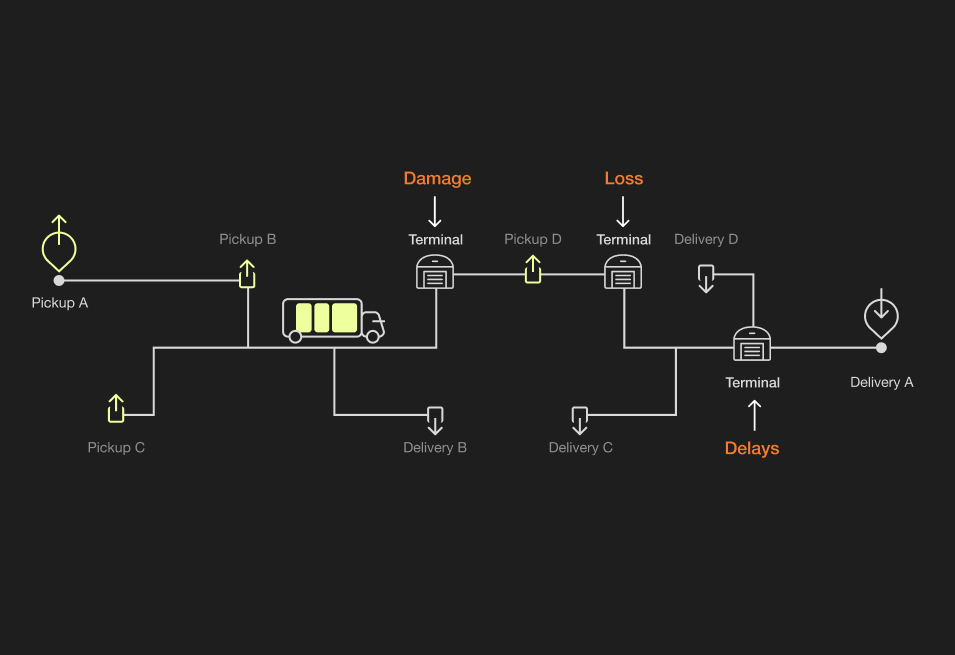The Ultimate LTL Freight Shipping Guide

Maximize your less-than-truckload (LTL) shipments by learning how to track your freight, determine your costs, and compare shipping modes in this LTL freight guide.
What is LTL freight?
LTL freight shipping is a means of transporting freight that doesn't occupy an entire trailer – often making it an ideal option for midsize freight that:
- is no more than 10 pallets
- is no longer than 12 linear feet
- weighs between 150 to 15,000 pounds
Since LTL freight allows shippers to pay only for the fraction of trailer space that their shipment occupies, shipping LTL can be a cost-effective option for growing businesses.
How to track LTL freight.
Because having visibility into your shipments keeps you informed and better able to proactively support your customers, a reliable LTL freight tracking process is crucial to ensuring that every delivery runs smoothly.Tracking your LTL freight involves three basic steps:
- choosing the right shipping partner
- completing important paperwork
- having the information you need to track your freight
Select an LTL shipping partner.
You’ll first need to decide whether to quote or book your LTL shipment in one of the following ways:
Directly with a freight carrier.
Of your three options, booking directly with a freight carrier presents the most risk and can be tricky even for the most experienced shippers. If this is your preferred route, be sure to ask the carrier these key questions:
- “What experience have you had moving my type of goods?”
- “How big is your network of LTL carriers in the area?”
- “Are there ways for me to save money on this load?”
- “Do you provide freight tracking?”
Through a freight broker.
Freight brokers are liaisons between shippers and carriers. They specialize in finding the most suitable carriers for specific shipments, optimizing transportation arrangements, and negotiating better rates on your behalf.Booking through a freight broker offers many benefits, including:
- a deep understanding of the constantly shifting industry
- an extensive carrier network
- load optimization
- flexibility and scalability
Using an online freight service.
Online freight services use software to provide flexible brokerage options through a digital platform. These self-service platforms offer shippers the biggest benefits of a freight broker – such as greater optimization and flexibility – while maintaining total control over their shipping operations.With an online platform, shippers can find the best rates, select a carrier, and keep an eye on their shipments in real time. In many cases, artificial intelligence provides load-matching capabilities and automation that allows shippers to save time on administrative tasks.
Complete a bill of lading.
The bill of lading (BOL) contains specific identifying details about your shipment – not only acting as “pre-flight checks” for your delivery but helping you avoid and recover lost or misdelivered shipments. An accurate BOL is critical to LTL freight tracking, because any incorrect or missing information makes your goods difficult to track and more susceptible to loss.Pro tip:Flock’s platform automatically generates a downloadable BOL from the details you input for your freight, so you don’t have to worry about expensive mistakes and can easily access it when needed.
Use PRO or other identifying number.
Most carriers provide a specific LTL tracking number called a “PRO number.” This is a common way for you to find information about your shipment en-route. Using your carrier-provided PRO number (or other identifying number), you can either:
- log into your carrier’s platform to see details about your freight’s whereabouts on your own
- contact your account manager or the customer service department directly
Pro tip: Don't want to call or email for tracking info? Flock’s platform provides detailed, up-to-date LTL freight tracking information to offer you easier oversight and more in-depth tracking at the touch of a button — in addition to our dedicated account managers and customer support teams.
Determining LTL freight costs.
Since your shipment is combined with others at a central hub, LTL freight costs can be significantly lower than shipping methods like full truckloads (FTL). However, the actual differences between LTL vs. FTL prices will largely be determined by which rate option you select and any additional fees that come along with delivery.
Contract rates.
A freight contract rate is a fixed price and volume for a set lane and set period of time. In exchange for stable, long-term work, carriers may even offer shippers lower-than-normal rates.
Spot rates.
A spot rate is a one-time price offered by a freight service provider. Because these rates fluctuate daily with market demands depending on factors such as global trade and inflation, they can differ greatly from contracted rates – sometimes being much higher or substantially lower.Choosing wisely between spot rates and contract rates can dramatically affect the cost of your LTL freight shipping. Evaluate the market, your budget, and your shipping needs when deciding which rate is best for your freight.
How does LTL compare to other shipping methods?
A recent Flock study found that nearly half of all truckloads in 2022 moved partially empty – and the equivalent of nearly 1 in 5 truckloads moved completely empty. Although FTL delivers fast, it often leads to overpaying for unutilized space, while LTL freight maximizes available truck space and cuts down expenses. Still, it’s important to review all your options before selecting the best shipping mode for your freight. Consider:
- the type of freight you're shipping
- your timeline and flexibility
- your budget
- the size and weight of your shipment
LTL vs. FTL.
FTL shipping is a shipping method that uses the entire trailer to bring your freight directly from the pick-up location to the destination. With FTL shipping, you reserve and pay for an entire truck – whether or not you completely fill it. This often makes FTL a more expensive option than LTL freight.When comparing LTL vs. FTL rates, keep in mind that FTL offers faster delivery times and a reduced risk of damaged or missing items. That’s because, unlike LTL, it requires no stops at terminals — meaning goods see less handling.Choose FTL if your shipment is:
- over 40 feet long
- delicate, expensive, or high-risk and would stay safer with minimal handling
- time-sensitive and needs firm delivery and pick-up dates
Partial truckload vs. LTL.
Partial truckload (PTL) shipping is similar to LTL in that it caters to freight that is smaller than a full truckload. With PTL, your freight is combined with partial loads from other shippers going in the same direction and delivered to its destination with minimal handling and stops.The main differences between partial truckload vs. LTL shipping are:
- PTL shipments typically range from 10,000 to 40,000 pounds, while LTL freight is 150 to 15,000 pounds
- unlike PTL, LTL freight routes often include consolidation points, known as a terminal, where cargo is unloaded, reorganized, and reloaded — increasing the total transit time and the risk of damaged or lost cargo
Shared truckload vs. LTL.
Just like LTL and PTL, shared truckload (STL) shipping allows multiple shippers to share trailer space in one multi-stop full truckload. However, STL freight isn’t handled during transit, traveling directly from pickup to destination without passing through hubs or terminals. STL has no freight class requirements or weight minimum. This means that STL functions a lot like FTL shipping – but without the need to fill or pay for an entire truck. This method offers lower risk of damages, faster delivery times, and no accessorial fees. STL’s streamlined travel also reduces greenhouse gas emissions by up to 40%.Choose STL if you:
- want lower rates than FTL without sacrificing service or reliability
- have 10–44 linear foot shipments that are too big for LTL freight but too small to fill a full truckload
- have flexibility in your schedule
Book with Flock to maximize LTL efficiency.
Don’t agonize over wasteful, inefficient shipments that hurt your bottom line. When your business ships with Flock Freight, you’re always getting the most efficient and cost-effective option for your freight. Flock offers multiple options for your shipment, allowing you to easily determine which method best fits your freight’s unique needs. Then, when you’re ready, book instantly on the Flock platform and track your freight in real-time.Book a call to learn how Flock can help maximize your operations’ efficiency by finding the best option for your freight.





